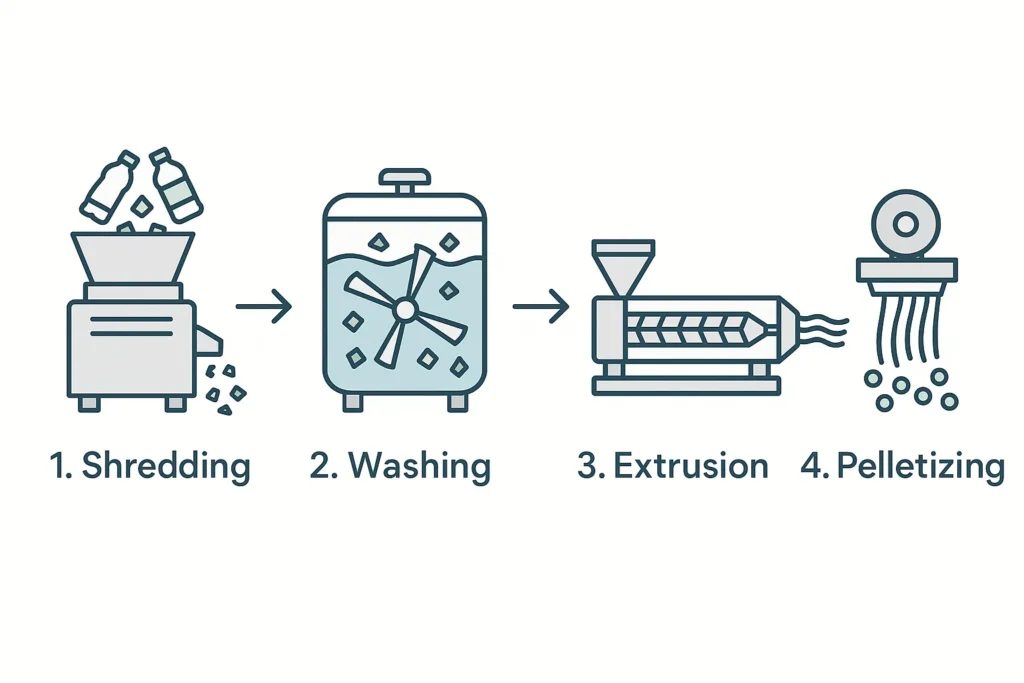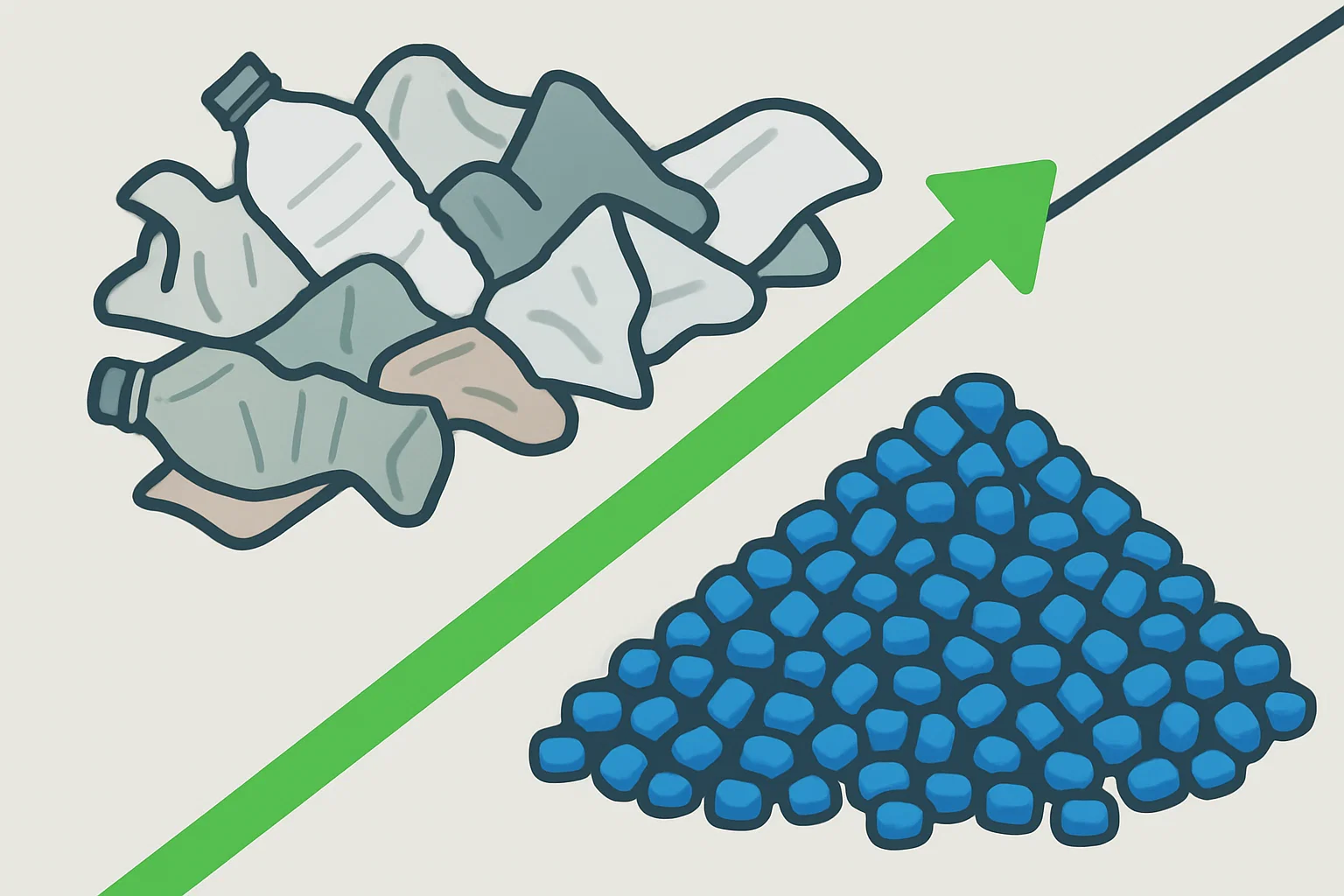Le pelletage plastique est l'étape finale cruciale du processus de recyclage des plastiques, transformant les déchets plastiques nettoyés et broyés en granulés uniformes et à haute valeur ajoutée. Si votre entreprise se démène pour gérer les déchets de plastique, réduire les coûts opérationnels ou améliorer l'efficacité de la production, comprendre ce processus n'est pas seulement bénéfique, c'est essentiel. Dans un monde confronté à des défis sans précédent liés à la pollution plastique, le recyclage des plastiques en granulés représente une solution puissante, transformant un problème coûteux en une opportunité profitable et formant le pilier d'une véritable économie circulaire.
Ce guide complet vous guidera à travers tout le processus de pelletage plastique. Nous explorerons les principes fondamentaux, plongerons dans les machines en action et révellerons les avantages significatifs qui font de cette technologie un pilier de l'industrie manufacturière moderne et durable.
Partie 1 : La Définition Fondamentale – Qu'est-ce que le Pelletage Plastique ?
Au fond, granulation de plastique est un processus industriel qui prend des déchets plastiques traités, tels que des films broyés, des bouteilles écrasées (flakes) ou des déchets industriels, et les transforme par fusion, filtration et coupe en granulés ou pellets petits et uniformes.
Imaginez-le comme transformer un tas de déchets de bois irréguliers et de sciure en pellets de bois parfaits et faciles à utiliser pour un poêle. Les déchets plastiques bruts sont souvent volumineux, contaminés et difficiles à manipuler. Les pellets finaux, en revanche, sont un matériau de base standardisé, propre et fluide, prêt à être réintroduit dans les cycles de fabrication pour créer de nouveaux produits.
Le but : Pourquoi transformer les déchets plastiques en pellets ?
La conversion des déchets en pellets ne s'agit pas seulement de changer la forme du matériau. Il s'agit d'un processus à valeur ajoutée conçu pour résoudre plusieurs problèmes fondamentaux dans le recyclage des plastiques.
- Standardisation pour la Fabrication : Les fabricants ont besoin de matières premières prévisibles. Les machines d'injection, de soufflage et d'extrusion qu'ils utilisent sont des instruments hautement précis qui nécessitent une matière première fluide et constante. Les déchets plastiques bruts sont tout sauf constants. Le pelletage plastique crée des granulés uniformes d'une taille, d'une forme et d'une densité spécifiques, garantissant qu'ils peuvent être dosés, transportés et fondus avec précision dans les machines de production suivantes sans causer de bouchons ou de variations de processus. Cette standardisation est la clé pour créer un matériau brut recyclé fiable et de haute qualité.
- Purification et Amélioration des Propriétés (Composant): L'étape de fusion du processus de granulation offre une opportunité unique de purifier et d'améliorer le plastique. Lorsque le plastique est fondu dans l'extrudeur, il est forcé à travers un filet à mailles extrêmement fines (un changeur de filet) qui élimine les contaminants résiduels tels que le papier, les fibres de bois ou les plastiques non fondus. De plus, c'est l'étape idéale pour introduire des additifs - un processus appelé composant. Un masterbatch de couleur peut être ajouté pour créer des granulés de couleur spécifique, des renforts comme les fibres de verre peuvent être mélangés pour augmenter la résistance, et des stabilisateurs UV peuvent être ajoutés pour améliorer la résistance aux intempéries. Cela transforme le matériau recyclé de base en un plastique d'ingénierie performant.
- Augmentation de la Densité Volumique pour la Logistique: Les films plastiques en vrac, les déchets broyés et même les épluchures de bouteilles ont une densité volumique très faible. Ils occupent une grande quantité d'espace pour leur poids, rendant le stockage et le transport extrêmement inefficaces et coûteux. Le processus de granulation plastique densifie considérablement le matériau. Un camion de granulés plastiques uniformes peut contenir plusieurs fois plus de matière réelle par poids qu'un camion de film en vrac, réduisant drastiquement les coûts de transport par livre et économisant de l'espace précieux dans les entrepôts.
- Créer un Produit Commercial: Dans l'industrie du recyclage, les matériaux standardisés sont des commodités précieuses. Les déchets plastiques non traités ont une valeur de marché très limitée, souvent volatile. Cependant, les granulés de plastique recyclé uniformes sont une commodité commercialement échangée avec une valeur stable et beaucoup plus élevée. Ils possèdent des fiches techniques techniques, des propriétés définies et sont considérés comme un substitut direct des résines plastiques vierges par de nombreux fabricants. Recycler le plastique en granulés élève le matériau de “déchets” à un “produit” industriel précieux.”
La chaîne complète – Comment fonctionne une machine de granulation de plastique en profondeur
Une ligne complète n'est pas une machine unique, mais un système intégré de composants fonctionnant en harmonie. Bien que les configurations varient en fonction du type de plastique et de son état, le processus de base suit une progression logique et multistage. granulation de plastique Infographie illustrant les 4 étapes du processus.

Le succès de la granulation plastique commence bien avant que le plastique ne soit jamais fondu. Un pré-traitement adéquat est incontestable pour produire des granulés de haute qualité.
Réduction de taille (cassage et broyage) :.
- Le déchet plastique brut doit d'abord être réduit à une taille cohérente et gérable. C'est là que les broyeurs industriels et les granulateurs sont essentiels. Pour des articles volumineux comme des tonneaux en plastique, des purges grandes quantités ou des films groupés, un broyeuse à fort couple et à faible vitesse.
- For bulky items like plastic drums, large purgings, or bundled films, a high-torque, low-speed shredder est utilisé pour la réduction primaire de taille.
- Pour des matériaux comme les tuyaux en plastique ou les plastiques rigides, un broyeur de tuyaux spécialisé ou un granulateur de grande capacité fournit une action de coupe plus agressive. L'objectif est de créer des éclats ou des copeaux petits et uniformes (généralement inférieurs à 12 mm) qui peuvent être introduits en douceur dans l'extrudeur de granulation. Pour une efficacité maximale, de nombreuses opérations utilisent une.
- machine broyeur et granulateur intégrée qui combine les deux étapes. Lavage et Séchage :.
- La plupart des plastiques post-consommation et post-industriel sont contaminés par de la poussière, du sable, de l'huile, des étiquettes en papier et de l'humidité. Ces contaminants doivent être éliminés. Le plastique broyé entre dans une ligne de lavage, qui peut inclure : Des réservoirs Flottants-Flottants :
- Float-Sink Tanks: Sépare les plastiques plus lourds (comme le PET) des plus légers (comme le PE/PP) et élimine les contaminants lourds tels que le sable et le métal.
- Essieux de frottement : Des pales à haute vitesse frottent les copeaux de plastique entre eux pour enlever les impuretés tenaces et les étiquettes.
- Lavage à chaud : Utilise de l'eau chaude et des détergents pour éliminer la graisse et la colle.
- Séchage : Après le lavage, le plastique doit être complètement séché. Toute humidité résiduelle se transformera en vapeur dans l'extrudeuse chaude, créant des bulles (vides) dans les granulés finaux et dégradant la qualité du plastique. Cela est réalisé à l'aide de sécheurs centrifuges et de systèmes de séchage thermique.
Étape 2 : La Phase d'Extrusion en Mélange
C'est le cœur de la machine de granulation de plastique, où les copeaux de plastique préparés sont transformés en un polymère fondu homogène.
- [29] Introduit les déchets de plastique bruts et nettoyés (paillettes ou films) dans le système à un rythme contrôlé. Des copeaux propres et secs sont alimentés depuis un silo dans l'extrudeuse. Pour des matériaux légers et épais comme les films, un doseur à force ou un compacteur peut être utilisé pour densifier le matériau et assurer un débit régulier et constant dans le tige de l'extrudeuse.
- L'Extrudeur : L'extrudeur est un long tube chauffant contenant un ou deux screws tournants (dans un extrudeur à double screw). À mesure que le screw tourne, il transporte les copeaux plastiques vers l'avant. La combinaison de la friction due au mouvement du screw et de la chaleur des bandes chauffantes extérieures fait fondre le plastique. La conception du screw est hautement ingénierisée pour comprimer, mélanger et homogénéiser le plastique fondu, assurant une température et une viscosité constantes.
- Évacuation/Dégazage : Les extrudeurs de haute qualité sont équipés de barils ventilés. Ce sont des ports de vide le long du tube qui aspirent toute humidité, air et autres gaz volatils restants qui sont libérés lors de la fonte du plastique. Cette étape est cruciale pour éviter la porosité dans les granulés finaux et assurer une surface lisse et de haute qualité sur les produits en eux-mêmes.
- Filtration du mélange fondu : Avant que le plastique fondu ne puisse être coupé en granulés, il doit passer par une dernière étape de filtration. Un changeur de tamis tient une maille métallique fine qui attrape les derniers contaminants solides (métaux, charbon de carbone, etc.) qui n'ont pas été éliminés pendant le lavage. Cela protège l'équipement aval et garantit la pureté du produit final.
Étape 3 : La Phase de Granulation et de Refroidissement
Une fois que le plastique est un mélange propre et homogène, il est prêt à être coupé en granulés. Il existe trois méthodes principales pour cela, chacune ayant ses propres avantages.
- 1. Granulation en Fil (Système de Coupure Froide) : C'est la méthode la plus courante et la plus simple.
- Processus : Le plastique fondu est extrudé à travers un die avec de multiples petits trous ronds, formant des fils continus ressemblant à des spaghettis. Ces fils sont immédiatement plongés dans un long bac ou bassin d'eau pour se refroidir et se solidifier. À la fin du bac, les fils durcis sont tirés vers un granulateur, qui utilise un ensemble de lames tournantes pour les couper en granulés cylindriques courts.
- [37] Idéal pour : Une large gamme de polymères, particulièrement adaptée aux tests et à la production en petites séries en raison de sa simplicité.
- 2. Pellettisation par Anneau d'Eau (Système de Coupe à Face de Dies Chauds) : Il s'agit d'un système plus automatisé et plus compact.
- Processus : Le plastique est extrudé directement dans le chemin d'une tête de coupe tournante à travers le die. Au fur et à mesure que le plastique émerge, les lames le tranchent immédiatement en pâtes directement à la face du die. Un anneau d'eau circulant immédiatement attrape les pâtes chaudes, les refroidit et les transporte sous forme de pâte vers un sécheur centrifuge, qui sépare les pâtes de l'eau.
- [37] Idéal pour : Production à grande échelle de polyoléfines telles que le PE et le PP. Il produit des granulés en forme de lentille plus uniformes que le granulage en filaments.
- 3. Granulage sous-marin (UWP) : C'est le système le plus avancé et le plus sophistiqué.
- Processus : Similaire au tranchage à anneau d'eau, les granulés sont tranchés à la face chaude du die. Cependant, toute la chambre de coupe est inondée d'eau à température contrôlée. Les granulés sont tranchés, refroidis et solidifiés dans un environnement fermé unique avant d'être pompés vers un sécheur.
- [37] Idéal pour : Une large gamme de plastiques, y compris des matériaux sensibles à la température comme les nylon et les polymères collants. Il produit des granulés sphériques parfaits de la plus haute qualité et de la plus grande uniformité.
Après la coupe et le refroidissement, les granulés finis sont transportés par air vers un silo de stockage, où ils sont souvent passés à travers un classificateur pour éliminer toute pièce trop grande ou trop petite avant d'être emballés pour l'expédition.
Partie 3 : La valeur de l'entreprise – 4 avantages principaux du granulage de plastique
%% recyclage des déchets plastiques et le système de granulation offre des retours tangibles bien au-delà de la simple gestion des déchets.
- 1. Augmentation significative de la valeur du matériel : C'est le bénéfice financier le plus direct. Vous transformez un flux de déchets à faible valeur (ou même négative) en une marchandise industrielle de haute valeur et en demande. Des granulés recyclés propres et uniformes peuvent souvent être vendus pour 60-80% du prix de leurs homologues vierges, créant un nouveau flux de revenus significatif.
- 2. Amélioration de l'efficacité de la fabrication à la aval : Pour les entreprises qui génèrent et réutilisent leurs propres déchets industriels (système "fermé"), utiliser du matériel granulé ré-pelletisé au lieu de matière première broyée brute offre de grands avantages. Les granulés uniformes s'engouffrent sans difficulté dans les machines de production, conduisant à des processus plus stables, moins de temps d'arrêt pour les blocages de matière, et un produit final de meilleure qualité. Cette amélioration directe de l'OEE (Efficacité Générale des Installations) se traduit par des coûts de production plus bas et des profits plus élevés.
- 3. Amélioration de la santé, de la sécurité et de l'environnement (HSE) : Le traitement de la matière première broyée en plastique en poudre peut créer une grande quantité de poussière dans l'air, ce qui peut être un danger respiratoire et, dans certains cas, un risque d'explosion de poussière combustible. La conversion de ce matériel en granulés propres et sans poussière rend le lieu de travail plus sûr et plus propre. De plus, le matériel densifié est plus facile à manipuler avec des équipements de transport standard, réduisant le travail manuel et le risque d'accidents.
- 4. Développement d'une véritable économie circulaire : Le pelletage plastique est la technologie permettant de développer une économie circulaire. Sans elle, la plupart des déchets plastiques ne peuvent pas être réutilisés efficacement dans des applications à haute valeur. En créant un approvisionnement fiable de matières premières recyclées de haute qualité, la granulation réduit notre dépendance aux combustibles fossiles pour produire des plastiques vierges, réduit l'empreinte carbone de la fabrication, et offre une solution réelle et scalable pour garder le plastique hors des décharges et des océans. Pour les entreprises modernes, c'est une histoire puissante à raconter aux clients et aux parties prenantes, améliorant la réputation de la marque et s'alignant avec les objectifs de durabilité de l'entreprise.
Partie 4 : Applications – La nouvelle vie des granulés de plastique recyclés
Une fois le recyclage des déchets plastiques processus terminé, les granulés obtenus deviennent les éléments constitutifs d'une vaste gamme de nouveaux produits.
- Moulage par Injection : Les granulés recyclés (en particulier le PP, l'HDPE et l'ABS) sont largement utilisés pour le moulage par injection de produits durables tels que les palettes de transport, les caisses, les poubelles, les composants automobiles (rebars, tableau de bord), les seaux et le mobilier extérieur.
- Moulage par soufflage : Les granulés recyclés en HDPE sont couramment utilisés pour le moulage par soufflage de contenants non alimentaires tels que les bouteilles pour les détergents, l'huile moteur et le shampoing, ainsi que des grands objets comme les barrels industriels et les canalisations d'évacuation.
- Extrusion : Les granulés recyclés sont extrudés en une variété de profils et de feuilles. Cela inclut des applications telles que le bois composite pour les dalles et les clôtures, les canalisations d'évacuation, les conduits électriques et les feuilles de plastique pour la construction et l'agriculture.
- Soufflage de film : Les granulés recyclés en LDPE et en LLDPE sont soufflés pour former de nouveaux films utilisés pour les sacs poubelle, les feuilles de construction et les films agricoles.
- Fibres et textiles : Les granulés recyclés en PET (à partir de bouteilles) sont le principal matière première pour produire le fil à staple polyester. Ce fil est utilisé pour fabriquer des vêtements (jackets en fourrure), des tapis et le garnissage pour les coussins et les sacs de couchage.
Conclusion : Votre premier pas vers un recyclage rentable
Le pelletage plastique n'est pas seulement un processus de recyclage ; c'est une transformation stratégique de l'entreprise. C'est la méthode définitive pour convertir un flux de déchets problématique en une matière première précieuse, uniforme et rentable. De la réduction initiale de la taille avec des broyeurs et des granulateurs robustes à la production finale de granulés de haute qualité, chaque étape est une opportunité d'ajouter de la valeur et d'améliorer votre ligne de fond opérationnelle et environnementale.
Une opération réussie granulation de plastique dépend de machines fiables et à haute performance. Avoir l'équipement de pré-traitement approprié, comme un broyeur puissant adapté à votre flux de déchets spécifique, est la base d'un processus fluide et efficace.
Prêt à explorer comment une solution complète, de la broyage à la granulation, peut transformer vos déchets plastiques ? Contactez Rumtoo Machine aujourd'hui pour parler avec nos experts et concevoir un système adapté à vos besoins spécifiques.

